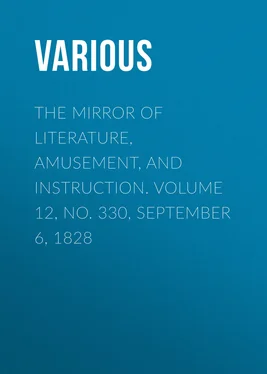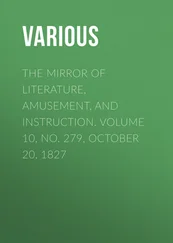Various - The Mirror of Literature, Amusement, and Instruction. Volume 12, No. 330, September 6, 1828
Здесь есть возможность читать онлайн «Various - The Mirror of Literature, Amusement, and Instruction. Volume 12, No. 330, September 6, 1828» — ознакомительный отрывок электронной книги совершенно бесплатно, а после прочтения отрывка купить полную версию. В некоторых случаях можно слушать аудио, скачать через торрент в формате fb2 и присутствует краткое содержание. Жанр: foreign_antique, periodic, Развлечения, foreign_edu, на английском языке. Описание произведения, (предисловие) а так же отзывы посетителей доступны на портале библиотеки ЛибКат.
- Название:The Mirror of Literature, Amusement, and Instruction. Volume 12, No. 330, September 6, 1828
- Автор:
- Жанр:
- Год:неизвестен
- ISBN:нет данных
- Рейтинг книги:5 / 5. Голосов: 1
-
Избранное:Добавить в избранное
- Отзывы:
-
Ваша оценка:
- 100
- 1
- 2
- 3
- 4
- 5
The Mirror of Literature, Amusement, and Instruction. Volume 12, No. 330, September 6, 1828: краткое содержание, описание и аннотация
Предлагаем к чтению аннотацию, описание, краткое содержание или предисловие (зависит от того, что написал сам автор книги «The Mirror of Literature, Amusement, and Instruction. Volume 12, No. 330, September 6, 1828»). Если вы не нашли необходимую информацию о книге — напишите в комментариях, мы постараемся отыскать её.
The Mirror of Literature, Amusement, and Instruction. Volume 12, No. 330, September 6, 1828 — читать онлайн ознакомительный отрывок
Ниже представлен текст книги, разбитый по страницам. Система сохранения места последней прочитанной страницы, позволяет с удобством читать онлайн бесплатно книгу «The Mirror of Literature, Amusement, and Instruction. Volume 12, No. 330, September 6, 1828», без необходимости каждый раз заново искать на чём Вы остановились. Поставьте закладку, и сможете в любой момент перейти на страницу, на которой закончили чтение.
Интервал:
Закладка:
As we have noticed the taste of the Greeks for music, it is but fair that we should allude to that of their successors. In ancient Rome, music was never popular. Combats of gladiators and wild beasts filled their theatres with streams of blood, instead of their resounding with music; and after the death of Nero, 1 1 "When Nero exhibited himself as a singer and flute-player on the stage at Naples, the musicians of that province assembled to hear him; and Suetonius tells us that the emperor selected five thousand among the best to be his household musicians, and clothed them in a rich and uniform dress."
that beautiful art was declared infamous, and by a public decree, banished from the city. In our theatres, however, heroes fight to music, from the Richard III. and Richmond of Shakspeare to the "terrific combats" of modern melodrame.
Anything is, however, better than despair, and let us hope that something may be done towards the amendment of our musical reputation. We have too much of what Cobbett would call the "dead-weight" in us to become adopted by Apollo as the "children of song;" but what with the school of music in Tenterden-street, and numberless juvenile prodigies, we may indulge the expectation of rising in the diatonic scale, and that too at no very distant period. Burney and Crotch were remarkable instances of precocious musical skill; and in the present day, children from eight to twelve sing the most popular Italian airs on the English stage, with remarkable accuracy.
Apropos, we hear of constitutions being set to music, for says the Foreign Review , "during the short revolution at Naples, in 1820, a Neapolitan was heard to swear that if the government intended that the new constitution should be understood or accepted by the people, they must first have it set to music by Rossini."
GARDENS OF THE ZOOLOGICAL SOCIETY, REGENT'S PARK
We are again in the Regents Park ; but we must leave its architectural splendour for the present, and request our readers to accompany us towards the eastern verge of the Park, to the Gardens of the Zoological Society, established in 1826, and whose members now amount to eleven hundred ! The grounds are daily filled with fashionable company, notwithstanding the great migrations which usually take place at this season of the year, and almost depopulate the western hemisphere of fashion. The gardens, independent of their zoological attractions, are a delightful promenade, being laid out with great taste, and the parterres boasting a beautiful display of flowers. The animals, too, are seen to much greater advantage than when shut up in a menagerie, and have the luxury of fresh air, instead of unwholesome respiration in a room or caravan. 2 2 It should, however, be noticed, that the object of the Zoological Society is not the mere exhibition of animals. In the original prospectus it is observed, that "Animals brought from every part of the globe to be applied to some useful purpose as objects of scientific research, not of vulgar admiration; and upon such an institution, a philosophy of zoology founded, pointing out the comparative anatomy, the habits of life, the improvement and the methods of multiplying those races of animals which are most useful to man, and thus fixing a most beautiful and important branch of knowledge on the permanent basis of direct utility." The Secretary of the Society is N.A. Vigors, Esq., M.A., F.R.S., &c. who, from his extensive attainments in the science of zoology, fills the office with honor to himself, and peculiar advantage to the public.
At page 413 of our last volume, the reader will find an abstract of the second anniversary of the Society, since which the Gardens in the Regent's Park have been opened for public inspection. We have accordingly availed ourselves of this privilege, and our draughtsman has been at some pains in the annexed sketch, together with the vignette portraits accompanying it. The " Bird's-Eye View " will be better explained by reference to the figures; thus,
1. Entrance Gate and Pay Hut.
2. Ditto Check Hut.
3. House and Ground for Emus :
Two awkward land birds, resembling ostriches. Their incapability of flying is compensated by the exceeding speed with which they run. They are natives of New Holland.
4. Central Walk.
5. Sloping Shrubbery of Defence.
6. Fields for Horses and Cattle.
7. Building for Bears, ,
communicating with their pit, in the centre of which is a pole with steps for the animals to ascend and descend. At the extremity of the upper walk, the pit is surrounded with a dwarf wall and coping, to which (since our sketch was taken) have been added iron rails. There are here two Arctic bears, and a small black bear, the latter brought from Russia, 3 3 He was previously at Sudborne, the seat of the Marquess of Hertford, where Toby, as our Russian friend was christened, became equally sagacious with bipeds, in distinguishing strong ale from small beer. To the former beverage, Toby became freely attached; but when we saw him at the Gardens in the Regent's Park, he appeared too docile for his companions.
and presented to the Society, by the Marquess of Hertford. There is usually a crowd of visiters about this spot, and the sagacity and antics of our four-footed friends ensure them liberal supplies of cakes and fruit, handed to them on a pole. We were much interested with their tricks, especially with the vexation betrayed by one of them, at the top of the pole, when he saw his companion below seize a cake which the former had previously eyed with great gout . His wringing and biting his paws reminded us of many scenes out of a bear-pit. Then the snorting and snarling of the old bear below, when the young one attempted to obtain a cake thrown to him; and above all, the small share which our black friend Toby enjoyed, probably from his docility over-much,—like good-natured men who are mastered by those of rough natures. We could have staid here a whole hour, watching their antics, and likening them to the little trickery of human nature.
8 and 9. Ground enclosed for Kangaroos ,
of which there is a little herd, large and small. They are natives of New Holland. The fore legs are seldom more than twenty inches in length, whilst the hinder ones are sometimes three feet and a half long. They rest on the whole length of the hind feet, supporting themselves by the base of the tail, which, in truth, acts as a fifth leg, and is sometimes used as a weapon, being of such strength as to break a man's leg at a single blow. They move by leaps, which have been known to exceed twenty feet. Several kangaroos have been kept in the park at Richmond, and where they have produced young ones.
10. Dens
containing two fine leopards, a porcupine , and racoons . In an adjoining den are three wolves.
11. Gothic House for Lamas .
This is one of the most picturesque objects in the grounds. It contains two lamas. These animals are common in South America, particularly in the mountainous parts of Peru, where they are employed as beasts of burthen. One of the lamas was presented to the Society by the Duke of Bedford.
12. Circular Aviary for Birds of Prey
containing a fine griffon vulture , a white-headed North American eagle, hawks, falcons , and owls ; among the latter is the great horned owl . This is supposed by Linnaeus, and many antiquaries, to have been the bird of Minerva. The collection is remarkably splendid.
13. Hut for Beavers .
14. Hut for Foreign Goats.
15. Enclosed Area and Fountain for Aquatic Birds , as pelicans, Solan geese, China geese, black swans, &c.
Читать дальшеИнтервал:
Закладка:
Похожие книги на «The Mirror of Literature, Amusement, and Instruction. Volume 12, No. 330, September 6, 1828»
Представляем Вашему вниманию похожие книги на «The Mirror of Literature, Amusement, and Instruction. Volume 12, No. 330, September 6, 1828» списком для выбора. Мы отобрали схожую по названию и смыслу литературу в надежде предоставить читателям больше вариантов отыскать новые, интересные, ещё непрочитанные произведения.
Обсуждение, отзывы о книге «The Mirror of Literature, Amusement, and Instruction. Volume 12, No. 330, September 6, 1828» и просто собственные мнения читателей. Оставьте ваши комментарии, напишите, что Вы думаете о произведении, его смысле или главных героях. Укажите что конкретно понравилось, а что нет, и почему Вы так считаете.












